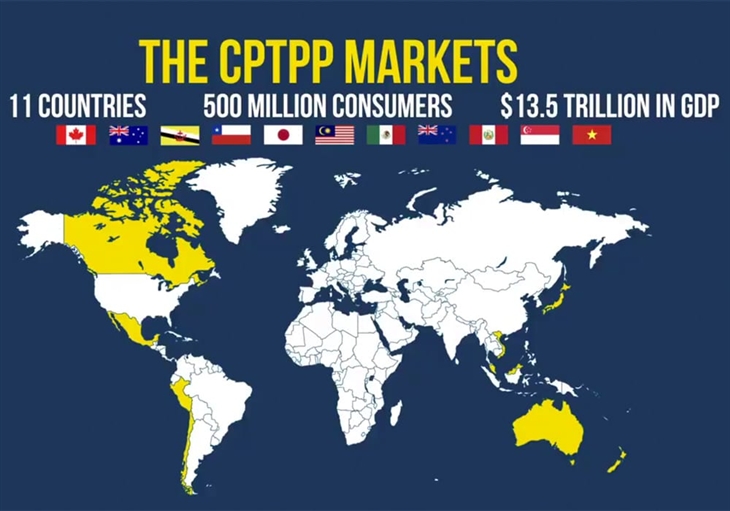
AsemconnectVietnam - The US-China trade war is bad news for the production chain-linked, trade-dependent economies of East Asia. The longer and broader the dispute becomes this year, the gloomier the headlines it will generate.
On the other hand, the tongue-twisting Comprehensive and Progressive Agreement for Trans-Pacific Partnership (CPTPP) may emerge as the good news story for East Asia – albeit a more low-key one. The larger it gets, the better it is for its members and the more attractive it becomes for those left outside.
The CPTPP is a new market reality for Japan, Canada, Australia, Mexico, Singapore and New Zealand – and will be for Vietnam from January 14. These seven economies, which account for more than 92 per cent of the total GDP of the 11 signatories, ratified the agreement in 2018. Malaysia, Chile, Peru and Brunei signed but did not ratify the agreement last year. The first three of those countries experienced disruptive changes of government in 2018; Brunei did not.
Reactions to the deal coming into effect provide early indications of its implications and the likely development of the 21st century’s first
mega-regional trade agreement.
The CPTPP is the smaller, narrower replacement for the earlier Trans-Pacific Partnership (TPP) signed by the current 11 CPTPP economies and the United States in February 2016. In January 2017, President Donald Trump killed the TPP agreement by withdrawing the US from it.
In 2008, influential US farm lobbies supported George W. Bush’s administration joining the negotiations that led to the deal, and subsequently the Obama administration making those negotiations the economic pillar of its “Asia rebalance” strategy.
Vince Peterson, head of US Wheat Associates, warned of an “imminent collapse” of the largest wheat export market for US growers. Japan is the largest export market for US and Australian beef, and has agreed to major tariff cuts for beef imports.
Instead of joining the CPTPP, the Trump administration will pressure Tokyo for a bilateral trade deal that includes the same – if not more generous – market access commitments for American agricultural exports.
If, as is likely, no such agreement is reached during Trump’s presidency, the next US administration may seek to reverse his decision and join the partnership.
Should this be the case, the US would not be alone.The list of governments considering joining the CPTPP is already more diverse than those that have ratified the agreement. They include South Korea, Taiwan and China (which boasts a larger GDP than the eleven CPTPP signatories combined), Thailand, Indonesia, the Philippines, Colombia and a post-Brexit Britain.
Taiwan, South Korea, and Thailand have been the most consistent in their interest, with the latter two appearing to be the most likely second-round joiners. For Thailand, the deal threatens to divert investment and trade from Thailand to Vietnam and possibly Malaysia. For South Korea and Taiwan, the threat is more competitive Japanese production chains becoming better able to access markets and production sites in the other signatory economies.
The most significant effect of the CPTPP could be to propel an even larger East Asian alternative that would ultimately supersede it.
Five of the seven governments that have ratified the CPTPP are also involved in the less successful mega-regional trade negotiations led by Asean for a Regional Comprehensive Economic Partnership (RCEP) agreement.
These negotiations have dragged on since 2013; they include the 10 Asean member-states, as well as China, Japan, South Korea, Australia, New Zealand and India. Despite many leadership pledges of renewed commitment for a speedy conclusion, fewer than half of the 18 chapters of a potential deal have been agreed.
RCEP supporters hoped the conclusion of the CPTPP negotiations would bring RCEP talks to a head. The opposite may be more likely.
Some RCEP parties not included in the CPTPP have castigated Australia and New Zealand in particular for trying to make the RCEP more like the TPP – which became the CPTPP. But if Australia and New Zealand have been criticised for being too ambitious, India’s RCEP position has been criticised for being too defensive, particularly towards China.
Negotiations have been stuck with more tunnel than light. Some RCEP parties have started to consider a parallel Asean-led process that excludes Australia, New Zealand and India.
An agreement among these 13 East Asian governments would be easier to conclude, could be conducted under the well-established Asean+3 process (which includes China, Japan, and Korea), and would be in line with China and Malaysian Prime Minister Mahathir Mohamad’s “Asia for Asians” preferences. The collective GDP of these 13 economies is more than twice that of the 11 CPTPP signatories.
Imitation is said to be the greatest form of flattery. This may not be the case for the CPTPP. Rather, imitation could be a prelude to replacement.
Source: Vitic/ scmp.com






